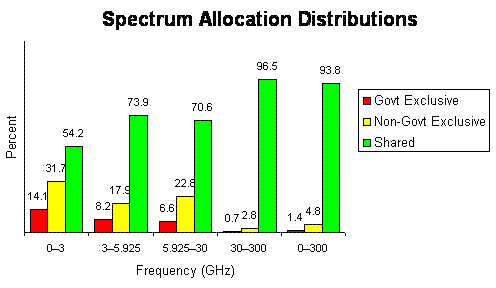How the Spectrum is Shared
Until recently, advanced technology has always kept slightly ahead of the demand for spectrum. As demand for spectrum has increased, technology has developed radios that can perform the same function at higher unused frequencies or increase spectrum efficiency and re-use of existing frequencies. Now, demand for spectrum is growing rapidly, both from expanded use of current services like cellular radio and precision landing systems for improved aviation safety, and the development of uses, such as PCS, digital audio broadcasting, advanced television, and satellite sound broadcasting. However, the technical advances needed to meet that demand may be "pushing the envelope" of practicality, at least in the short term. New technology cannot be expected to achieve further spectrum efficiency in the crowded radio spectrum below 3 GHz, unless cognitive functions are incorporated into the radios themselves to allow many unrelated users to share the same spectrum and affordable technology is not readily available for consumer wireless communications above 20 GHz.
The box below shows the growth in the number of active frequency authorizations at both NTIA and the FCC since 1980. At both agencies, there are twice as many assignments now as there were in 1980. Further, radio systems clearly are much more numerous today. They have also become more complex during this period, and the task of coordinating their use has become much more difficult. The flattening of the growth curve for NTIA assignments beginning in 1994 is the result of a congressionally mandated fee structure. At that time, NTIA began to charge an annual fee for each frequency assignment.

NTIA and the FCC manage their respective constituents' uses of the spectrum; however, both must keep in mind the overall best interests of the public. The two spectrum managers have divided the usable radio spectrum (0-300 GHz) into about 800 frequency bands, and have allocated these bands to 34 radio services (e.g., fixed, radionavigation, mobile, broadcasting, and various satellite services). The allocation plan continues to change to meet evolving domestic and international spectrum needs.
The following graphic shows the amount of spectrum allocated in the entire 0-300 GHz range to the federal government on an exclusive basis to be 1.4 percent, to the private sector on an exclusive basis to be 4.8 percent, and to the federal government and the private sector on a shared basis to be 93.8 percent. The graphic shows that in the 0-3.1 GHz range of the spectrum, where the government has about 92 percent of its operations, the amount allocated to the government on an exclusive basis is about 14.1 percent, to the private sector on an exclusive basis is about 31.7 percent and to both the federal government and the private sector on a shared basis is about 54.2 percent.

